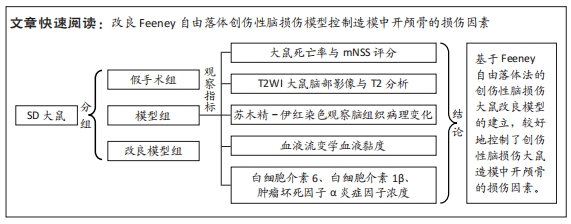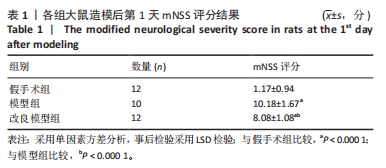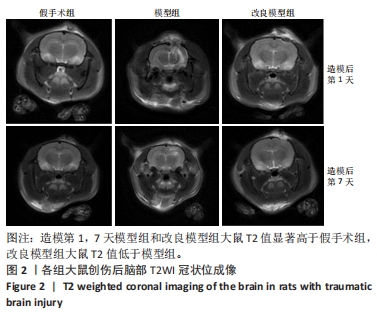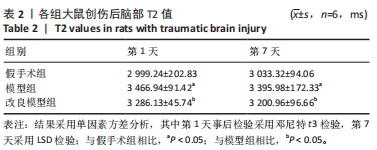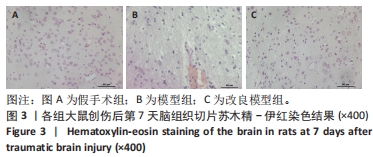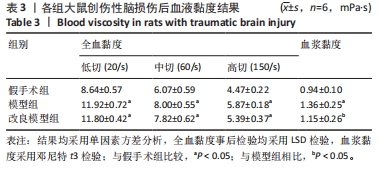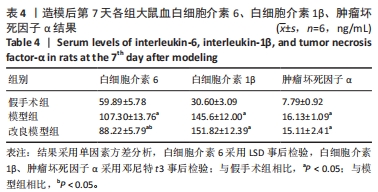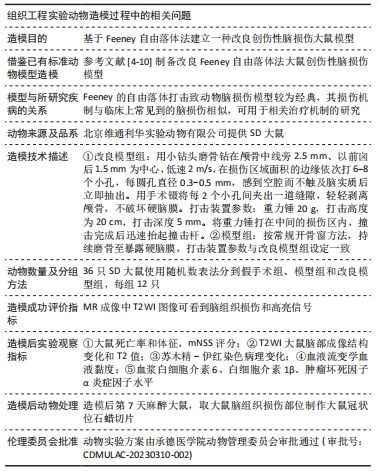[1] DE LUCA R, BONANNO M, RIFICI C, et al. Post-traumatic olfactory dysfunction: a scoping review of assessment and rehabilitation approaches. Front Neurol. 2023;14:1193406.
[2] 周建国,唐华民.创伤性脑损伤动物模型的研究进展[J].医学研究生学报,2019,32(5):546-551.
[3] ACKERMANS NL, VARGHESE M, WICINSKI B, et al. Unconventional animal models for traumatic brain injury and chronic traumatic encephalopathy. J Neurosci Res. 2021;99(10):2463-2477.
[4] PENG Y, ZHAO Y, HUANG Y, et al. Neuroprotective effects of low-intensity transcranial ultrasound stimulation combined with Baicalin intervention on traumatic brain injury in animals.Brain Res Bull. 2021; 175:246-253.
[5] HARRIS JP, MIETUS CJ, BROWNE K, et al. Neuronal Somatic Plasmalemmal Permeability and Dendritic Beading Caused By Head Rotational Traumatic Brain Injury in Pigs-An Exploratory Study. ront Cell Neurosci. 2023;17:1055455.
[6] FEENEY DM, BOYESON MG, LINN RT, et al. Responses to cortical injury: I. Methodology and local effects of contusions in the rat. Brain Res. 1981;211(1):67-77.
[7] 万佳.创伤性脑损伤动物模型的研究进展[J].系统医学,2022,7(10): 179-182.
[8] 刘媛, 王莉, 曾琳, 等. 一种改良的创伤性脑损伤模型的建立[J].中国临床神经外科杂志,2008,13(7):416-419.
[9] 李娜, 王瑞辉, 郭婕, 等. 电针对创伤性颅脑损伤大鼠炎症因子表达及神经功能的影响[J].陕西中医,2021,42(10):1358-1362.
[10] WANG Y, ZHAO W, JIANG ZL, et al. Intervention effects of miR-125b-5p on cognitive dysfunction induced by traumatic brain injury in rats and its mechanisms. Zhongguo Ying Yong Sheng Li Xue Za Zhi. 2022;38(5):424-429.
[11] CHEN J, SANBERG PR, LI Y, et al. Intravenous administration of human umbilical cord blood reduces behavioral deficits after stroke in rats. Stroke. 2001;32(11):2682-2688.
[12] HARRIS JP, MIETUS CJ, BROWNE K, et al. Neuronal somatic plasmalemmal permeability and dendritic beading caused by head rotational traumatic brain injury in pigs-An exploratory study. Front Cell Neurosci. 2023;17:1055455.
[13] DUHAIME AC. Large animal models of traumatic injury to the immature brain. Developmental neuroscience. 2006;28(4-5):380-387.
[14] KAWON K, SETKOWICZ Z, DROZDZ A, et al. The methods of vibrational microspectroscopy reveals long-term biochemical anomalies within the region of mechanical injury within the rat brain. Spectrochim Acta A Mol Biomol Spectrosc. 2021;263:120214.
[15] ODDO M, CRIPPA IA, MEHTA S, et al. Optimizing sedation in patients with acute brain injury. Crit Care. 2016;20(1):128.
[16] 马建军,何新泽,王浩琪,等.不同位置脑损伤模型大鼠坐骨神经的再生[J].中国组织工程研究,2017,21(36):5806-5811.
[17] FLIERL MA, STAHEL PF, BEAUCHAMP KM, et al. Mouse closed head injury model induced by a weight-drop device. Nat Protoc. 2009;4(9): 1328-1337.
[18] FODA MAAE, MARMAROU A. A new model of diffuse brain injury in rats: Part II: Morphological characterization.J Neurosurg. 1994;80(2): 301-313.
[19] ALBERT-WEIßENBERGER C, VÁRRALLYAY C, RASLAN F, et al. An experimental protocol for mimicking pathomechanisms of traumatic brain injury in mice. Exp Transl Stroke Med. 2012;4:1.
[20] KUNDU S, SINGH S. What happens in TBI? A wide talk on animal models and future perspective. Curr Neuropharmacol. 2023;21(5):1139-1164.
[21] STATEMENTS Q. VA/DoD clinical practice guideline for management of concussion/mild traumatic brain injury. J Rehabil Res Dev. 2009; 46(6):CP1-68.
[22] JIANG J, BU X, LIU M, et al. Transplantation of autologous bone marrow-derived mesenchymal stem cells for traumatic brain injury. Neural Regen Res. 2012;7(1):46-53.
[23] ZHAO J, CHEN N, SHEN N, et al. Transplantation of human umbilical cord blood mesenchymal stem cells to treat a rat model of traumatic brain injury. Neural Regen Res. 2012;7(10):741-748.
[24] 陈林, 杨翊, 刘经星, 等. 颅脑外伤实验动物运动方式的选择及神经功能评估研究进展[J]. 中华物理医学与康复杂志,2019,41(1): 76-78.
[25] 刘若尘, 吴涛, 王瑞辉, 等. 电针对创伤性颅脑损伤大鼠神经功能及损伤区脑组织p-JNK和Beclin-1表达的影响[J].针刺研究,2023, 48(5):475-480.
[26] ZHENG T, DU J, YUAN Y, et al. Effect of low intensity transcranial ultrasound (LITUS) on post-traumatic brain edema in Rats: evaluation by isotropic 3-dimensional T2 and multi-TE T2 weighted MRI. Front Neurol. 2020;11:578638.
[27] NAUMENKO Y, YURYSHINETZ I, ZABENKO Y, et al. Mild traumatic brain injury as a pathological process. Heliyon. 2023;9(7):e18342.
[28] 刘港, 邓博文, 蒋昇源, 等. 川芎嗪改善脊髓完全横断大鼠血液流变学指标的动态观察[J].中国组织工程研究,2023,27(2):282-286.
[29] 陈春富, 郭述苏, 樊红, 等. 高粘血症患者血液流变性与脑血流的相关研究[J].中国血液流变学杂志,1995,5(2):38-39.
[30] EKMARK‐LEWÉN S, FLYGT J, FRIDGEIRSDOTTIR GA, et al. Diffuse traumatic axonal injury in mice induces complex behavioural alterations that are normalized by neutralization of interleukin‐1β. Eur J Neurosci. 2016;43(8):1016-1033.
[31] TUTTOLOMONDO A, PECORARO R, PINTO A. Studies of selective TNF inhibitors in the treatment of brain injury from stroke and trauma: a review of the evidence to date. Drug Des Devel Ther. 2014;8: 2221-2238.
[32] BOURAS M, ASEHNOUNE K, ROQUILLY A. Immune modulation after traumatic brain injury. Front Med (Lausanne). 2022;9:995044.
[33] LIU YY, LI Y, WANG L, et al. Mesenchymal stem cell-derived exosomes regulate microglia phenotypes: a promising treatment for acute central nervous system injury. Neural Regen Res. 2023;18(8):1657-1665.
[34] 尹洁. 脑外伤致大鼠血液黏度、脑细胞NGB表达变化及其相关性的研究[D].兰州:兰州大学,2008.
|
